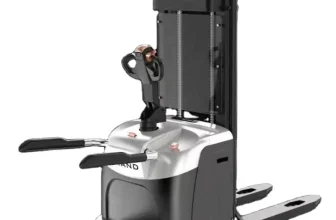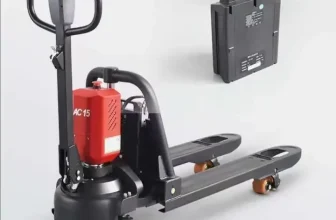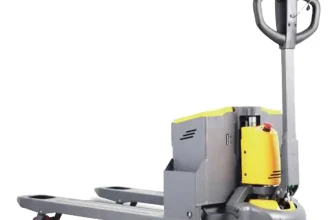A pallet jack, also known as a pallet truck, pump truck, or jigger, is a tool used for lifting and moving pallets within a warehouse or any storage facility. It is specifically designed for material handling and is an integral part of inventory operations in various industries. Its function involves sliding the forks into the pallet’s open areas, then using either manual or powered lifting mechanisms, raise the pallet off the ground to a determinable height, allowing it to be transported and positioned with minimum effort. The pallet jack’s simple yet functional design helps businesses optimize their workflow by reducing labor-intensive tasks, therefore boosting productivity.
Importance and uses of Pallet Jacks in storage and industrial sectors
Pallet jacks play a crucial role in the storage and industrial sectors around the globe. Their primary use is to lift and move pallets, significantly reducing the physical burden and time involved in moving goods manually. They are a common sight in warehouses, factories, and other industrial settings where large quantities of goods are handled regularly.
Pallet jacks also increase the safety of the work environment. Without them, workers would need to move heavy loads manually, which can lead to strain injuries or accidents. On the other hand, pallet jacks allow for safe and efficient transportation of goods, minimizing the risk of such incidents.
Furthermore, using pallet jacks leads to increased efficiency in the use of storage space. With their slim design, they can easily maneuver in tight spaces that wouldn’t be accessible with larger machinery. This allows businesses to effectively utilize their storage facilities, keeping their operations streamlined and reducing costs.
In the retail industry, pallet jacks are frequently used to arrange goods in storage rooms and bring them forth to replenish shop shelves. They are also commonly found in delivery trucks, where they help in loading and unloading goods.
In a nutshell, pallet jacks are the workhorses of the storage and industrial sectors, providing invaluable help in lifting, moving, and arranging heavy loads. They are fundamental to safety, efficiency, and productivity in these sectors.
Pallet Jack Varieties
Traditional Manual Pallet Jacks
Traditional Manual Pallet Jacks represent the most fundamental form of this indispensable tool. Their simplicity, affordability, and reliability have solidified their position in warehouses, factories, and retail spaces worldwide.
These jacks work on the principle of hydraulic power lifting, which is operated by the manual pumping of the handle. Despite their manual operation, they are potent tools capable of lifting and moving hefty loads. They feature two forks that slide underneath the pallet, lifting slightly off the floor for smooth movement. This simple action allows operators to transport goods from one location to another swiftly and safely.
Manual Pallet Jacks are highly maneuverable, making them the tool of choice for operations in tight spaces. They also require minimal maintenance, adding to their cost-effectiveness over time. Furthermore, they are incredibly durable and can withstand the wear-and-tear of daily operations for years or even decades, depending on their make and use.
However, their manual operation may limit the weight they can handle, while their dependence on human strength and effort may not make them the best choice for operations involving more massive goods or longer distances. Despite these limitations, when it comes to simplicity and reliability, Traditional Manual Pallet Jacks often remain the go-to option.
Electric or Powered Pallet Jacks
Electric or Powered Pallet Jacks are a modern, motorized variation of the classic manual jacks, designed to reduce manual labor and increase efficiency. As the name suggests, they run on either a built-in electric engine or external power sources.
These jacks are particularly useful in larger warehouses or factories, where goods need to be moved across long distances. They come with a throttle for movement control, buttons for lifting and lowering the forks, and sometimes, even have a platform for the operator to stand on, making them a significant upgrade from the traditional manual versions.
The standout feature of electric pallet jacks is their lifting power. Thanks to their electric engines, they have substantially higher capacities than manual jacks. This makes them ideal for lifting very heavy loads or pallets. However, that considerable lifting power comes with a higher price tag. Therefore, they are typically acquired by businesses with higher workloads and bigger budgets.
High lift Pallet Jacks
High lift pallet jacks form a specialized category within the range of pallet jacks available on the market. Compared to their standard counterparts, these innovative tools lift pallets to a significantly greater height. This allows better accessibility and ergonomic advantages during loading or unloading tasks.
Distinctively, the forks on these jacks can be raised from the floor up to waist height in some cases. This serves as a two-fold benefit. On one hand, the raised pallet aids in reducing the physical strain related to bending over and manually handling materials. On the other hand, it provides the operator with better visibility, which enhances safety in busy warehouses.
High lift pallet jacks are particularly essential when there is a requirement to stack products vertically to conserve space. However, with the additional functionality comes a higher price tag, making these jacks a more substantial investment than other types.
Though they offer increased elevation, these jacks follow the same operational principles as other types, with the main difference in the hydraulic system that enables high lifting. Therefore, navigating them is relatively simple and worker training is straightforward. Ultimately, high lift pallet jacks streamline tasks efficiently, offering a remarkable combination of capacity and convenience.
Comparison of these varieties based on lifting power
When comparing the lifting power across different pallet jack varieties, it’s evident that each type brings its own advantages to the table.
Manual pallet jacks, also known as hand pallet jacks, are typically able to lift loads between 2,500 and 5,500 pounds. These pallet jacks provide a good balance of power and cost-effectiveness, making them suitable for many small-to-medium scale operations. They feature simplistic design and are manually operated which means their lifting power is dependent on the physical force applied by the operator.
On the other hand, electric or powered pallet jacks offer a higher lifting capability – usually between 3,000 to 8,000 pounds. This substantial lifting power makes them ideal for larger and heavier loads that would be too strenuous to move with a manual pallet jack. Their operation is dependent on a chargeable battery, reducing manual labor and increasing efficiency in the process.
High lift pallet jacks round out our comparison with their specialized design. They generally have a similar load capacity to manual pallet jacks, around 2,200 to 3,500 pounds. However, they can lift pallets higher off the ground, which can be beneficial for stacking or placing goods on shelves.
It’s worth noting that the lifting power is not the only element to consider when choosing between different types of pallet jacks. Other factors such as budget, the type of goods to be lifted, and the physical space available can also play into this important decision.
Lifting Capabilities of Different Pallet Jacks
Lifting Capacity of Manual Pallet Jacks
Manual pallet jacks are the most common type primarily due to their simplicity, cost-effectiveness, and surprisingly high lifting capacity. They operate on a hydraulic system which is activated by ‘pumping’ the handle, this action creates pressure forcing the forks upward carrying the pallet along with it.
The lifting capacity of manual pallet jacks largely varies, although a standard jack can typically lift pallets that are about 3,000 to 5,000 pounds in weight. But this isn’t a steadfast rule, some heavy-duty manual jacks have been constructed to move up to 11,000 pounds.
While it’s impressive, bear in mind that manual pallet jacks depend on the physical strength of the operator. The heavier the cargo, the more force is required to pump the handle and get the load off the ground. Therefore, while possible to lift 5,000 pounds, this task can potentially be physically demanding and time-consuming. This makes heavier loads best suited to electric or high lift pallet jacks which we’ll explore next.
In a nutshell, manual pallet jacks are durable workhorses in environments where not exceedingly heavy loads need to be transported over short distances.
Lifting Capacity of Electric Pallet Jacks
Electric pallet jacks, also referred to as powered pallet jacks, are a significant upgrade from manual ones in terms of lifting capability. While their operation is more complex and requires training, they deliver substantially higher power and reduce the physical strain on the operator.
As a standard, most electric pallet jacks can lift loads ranging from 3,000 pounds to about 4,500 pounds. There are also heavy-duty models that are capable of lifting up to 8,000 pounds. These capacities are significantly higher than that of manual pallet jacks, making electric pallet jacks ideal for heavier or bulkier goods.
This elevated lifting power of electric pallet jacks is courtesy of their motor-driven hydraulic system, which lifts and lowers the forks. The lifting capacity is also influenced by the design of the jack, including the size of the forks and the materials used in its construction. Overall, these pallet jacks substantially reduce the effort needed in material handling tasks, enhancing efficiency significantly.
Lifting capacity of High Lift Pallet Jacks
High lift pallet jacks are the giants of the pallet jack family and offer significant lifting capacities. They are specifically designed to lift and transport heavier loads, thus widening the scope of operations they can handle.
Their standout feature is their incredible lifting power. Most high lift pallet jacks can lift loads up to 3300 lbs, making them a perfect solution for heavy-duty tasks. Some specialized high lift pallet jacks can even exceed this standard, lifting weights up to 3500 lbs or 4000 lbs.
It’s important to note that the lifting capacity can be affected by the material and build of the pallet jack. Generally, high lift pallet jacks are made from sturdy materials like steel to enhance their durability and ensure they can effectively lift heavy weights.
Additionally, the size of the forks also contributes significantly to the lifting capability of these extraordinary machines. Larger forks can better distribute the weight of the load, thus making it safer and easier for the user to lift and transport substantial weights.
Remember, these are average values. Different manufacturers offer machines with varying specifications tailored to meet different operational needs. Always check the product specifications from the manufacturer to understand the exact lifting capacity and ensure it aligns with your operational demands.
Factors influencing lifting capabilities such as material, build, size of forks
One of the most crucial aspects to consider when evaluating the lifting capability of a pallet jack is the material from which it is made. While many pallet jacks are made of steel, some are made of aluminum, which, although lighter in weight, may not be as resilient when supporting heavier loads. Hence, steel constructed pallet jacks often offer higher lifting capacities.
The build of the pallet jack also plays a vital role in its lifting capabilities. The strength and durability of the components, such as the hydraulic pump, the wheels, and the handle, can significantly impact how much weight a pallet jack can handle. For instance, pallet jacks constructed with reinforced steel and robust hydraulic systems will have higher weight capacity.
Another considerable aspect is the size and design of the forks. The length and width of the forks can affect lifting capacity in two ways. A wider fork provides a more stable base, arguably allowing for heavier loads. On the other hand, the size of the forks must also be suitable for the pallets being lifted. If the forks are too long for a particular pallet, they may not provide the needed support, reducing the jack’s effective lifting capacity.
Tolerance for weight is unique to each pallet jack model and type, and as such, it’s always a good idea to verify the specifications provided by the manufacturer and make sure they align with your operational requirements.
Safety Considerations when using a Pallet Jack
Importance of not exceeding maximum lift capacity
Exceeding the maximum lift capacity of a pallet jack is a common mistake to avoid due to its risk factor and potential damage. Each pallet jack possesses a designated limit concerning how much weight it can safely manage. Going beyond this specified limit may lead to dangerous situations and significantly lessen the lifespan of the equipment.
Operating a pallet jack over its load limit can trigger unstable load handling. Loads that are too heavy foster difficulty in maneuverability and are more prone to slipping or tipping over, causing potential harm to both the operator and synonymous equipment and supplies around.
Furthermore, consistently overloading a pallet jack weakens its structural integrity. The jacks are not designed to handle more than their optimal weight. Hence, continuous overloading puts extra strain on components like wheels, bearings, and hydraulic systems, leading to their premature failure.
Therefore, it’s crucial always to adhere to the maximum lift capacity mentioned by the manufacturer. This not only ensures a safe work environment but also enhances the prolonged efficiency of your pallet jack. Remember, safety surpasses speed, so it’s never wise to compromise safety standards for relatively quicker operations.
Proper operation techniques
To ensure safety and efficiency while using a pallet jack, it’s critical to master proper operation techniques. Firstly, before handling any load, operators must verify the pallet jack’s functionality by doing a quick inspection of key elements like handles, wheels, and the hydraulic system.
Before lifting, operators should position the forks entirely under the load, ensuring that the load is uniformly distributed across both forks. This is important to prevent tipping or an unsteady load which could lead to accidents.
Next, it’s important to lift or lower the jack using the handle carefully, making sure that the entire process is smooth and gradual. Abrupt movements could cause the load to shift, posing a safety hazard.
While moving the loaded pallet jack, the operator should always maintain a safe and slow speed. Running with a pallet jack or making sudden movements can lead to loss of control, potentially resulting in injuries or property damage. It is recommended to always push the load rather than pulling as this allows for better control and visibility.
Lastly, but perhaps most importantly, the operator should always be aware of their surrounding environment. This includes looking out for potential obstacles, wet or uneven floors, and ensuring that the path is clear before moving the load. Any abrupt stop or change in direction may destabilize the load and cause accidents.
By following these operation techniques, one ensures maximum safety and efficiency while utilizing a pallet jack.
Maintenance aspects for enhanced safety and longevity
Routine maintenance of a pallet jack is crucial for its enhanced safety and longevity. Regular inspections and servicing ensure that the jack remains in optimal operative condition, thus reducing the risk of accidents due to equipment failure.
Bear in mind that all components of the Pallet Jack, including the hydraulic pump, wheels, handle, and forks, require timely inspection. Watch out for signs of wear and tear, such as dents, cracks, or bends in the forks, problems in the steering, or difficulties in lifting loads. If you encounter difficulties in maneuvering the jack or if it’s unable to lift loads to the maximum height, it could denote a problem with the hydraulic pump.
Greasing and lubrication are also important parts of regular maintenance. This not only smoothens the pallet jack’s operations but also reduces the wearing down of its parts. Wheel maintenance, such as cleaning and checking for obstructions, is key as well, as it ensures smooth and efficient movement. Replacing wheels that are heavily worn can prevent accidents and improve maneuverability.
Lastly, ensure that any repairs or replacements of parts are done professionally to maintain the integrity and safety of the tool. Following these maintenance best practices will not only make your pallet jack last longer but also create a safer working environment. By understanding the importance of these maintenance aspects and implementing them regularly, you can add years to your pallet jack’s life and maintain a high level of productivity in your operations.
Choosing the Right Pallet Jack
Factors to consider – lifting requirements, budget, type of goods
When choosing the right pallet jack, there are several factors that you must consider. Firstly, think about your lifting requirements. This includes both the weight and height at which you regularly need to lift items. For instance, if your business necessitates moving heavy goods, an electric pallet jack might be more suitable due to its higher lifting capacity. Alternatively, if your lifting needs are minimal and infrequent, a manual pallet jack may suffice, offering a cost-effective choice.
Budget is another crucial factor. Pallet jacks come in a wide price range, primarily depending on their type and functionality. While manual pallet jacks are generally more affordable, electric or high-lift pallet jacks can be more expensive owing to their advanced features and higher lifting capabilities. Therefore, your budget may dictate the type of pallet jack you can afford. However, always consider the long-term value, not just the upfront cost. A more expensive pallet jack could prove to be a worthwhile investment if it improves efficiency and productivity.
Lastly, you must consider the type of goods that you will be moving. Are they fragile or sturdy? Are they large single items or small multiple items? The size, shape, and nature of the goods might require specific types of pallet jacks. For instance, electric pallet jacks are often better suited for moving delicate items as they offer a smoother ride compared to manual versions.
By taking into account your lifting requirements, budget, and the nature of your goods, you’ll be well placed to choose a pallet jack that efficiently meets your needs while offering the best value for your investment.
The role of the environment where the device will be used
The environment in which the Pallet Jack will be used is a key factor that can directly impact the performance, efficiency, and lifespan of the equipment.
Different settings may require different types of pallet jacks. For instance, if you are operating in a warehouse with narrow aisles and tight spaces, a compact and maneuverable pallet jack may be the appropriate choice. In contrast, if the environment involves rough, uneven terrains such as construction sites or outdoors, then you might need to consider a rugged, all-terrain pallet jack.
Temperature can also influence your choice of Pallet Jack. Freezer or cold storage facilities may require specific types of pallet jacks that can withstand extreme cold. Similarly, if the pallet jack is to be used in an environment with potentially explosive materials, an explosion-proof pallet jack may be necessary for safety reasons.
Humidity and dampness can affect the longevity of a Pallet Jack. If used in such environments, a Pallet Jack with corrosion-resistant properties could be a prudent choice.
Lastly, the environment’s noise levels should also be contemplated. For workplaces that value a quiet atmosphere, electric pallet jacks can be more suitable because they operate more silently than manual ones.
In conclusion, understanding the physical conditions and specific requirements of the environment where the Pallet Jack will function is vital to making an informed purchase decision. This will ensure both the efficiency of operations and the long-term durability of the equipment.
Importance of quality and brand reputation
Quality and brand reputation play a significant role when choosing the right Pallet Jack. A high-quality pallet jack promises durability, strength, and longevity, ensuring optimal productivity at your warehouse or industrial site. Cheap and poorly manufactured pallet jacks may initially seem cost-effective but often need frequent maintenance or early replacement which could eventually lead to more downtime and less productivity.
Choosing a reputable brand ensures consistency in performance and quality. Brands that have established a positive track record often offer better customer support and aftercare, ensuring that parts are readily available and that any issues or concerns are swiftly dealt with. They’re also more likely to comply with safety regulations and industry standards. This means you can be confident in both the safety and effectiveness of your equipment, protecting your investment in the long-term.
In short, never underestimate the importance of quality and brand reputation when choosing a Pallet Jack. It’s not just about the initial purchase price but also about the long-term costs and benefits to your operation. Whether you opt for a manual, electric, or high lift pallet jack, ensuring it’s a quality tool from a reputable brand will save you headaches, time, and money in the future.
Conclusion
Recap of the importance and uses of Pallet Jacks
Pallet jacks are an integral tool to many industries with heavy lifting and storage needs. They increase the efficiency of operations by transporting heavy loads swiftly across warehouses, factories, and storage spaces. With their varying types – traditional manual jacks, powerful electric jacks, and high lift jacks, they offer solutions for multiple scenarios requiring different lifting capacities. Their versatility makes them an indispensable asset. Despite their different specs, the underlying uses remain the same – moving, lifting, and handling palletized goods safely and efficiently. Selecting the right pallet jack should be done cautiously, considering various factors like the type of goods, environmental conditions, budget, and lifting requirements to ensure a wise investment. Quality should never be compromised, as a well-built reliable pallet jack can serve for many years, ensuring smooth workflow and reducing risks associated with heavy lifting.
Emphasis on choosing the right Pallet Jack based on lifting needs.
As we have established, pallet jacks come in an array of types and each type possesses its distinct lifting capacity. Businesses should prudently choose the right pallet jack that aligns perfectly with their daily operations, specifically their lifting needs.
Whether it’s a manual pallet jack, electric pallet jack, or a high lift pallet jack, your final decision should seamlessly fit your lifting requirements. Manual ones might be affordable, but if your lifting necessities consistently demand higher capacity, the cost-effective choice would be to go for electric or high lift pallet jacks.
By owning a pallet jack well-suited to your lifting needs, you not only enhance your operational efficiency but also ensure the safety of your workers. With this, you significantly reduce the possibilities of accidents that may occur due to overloading or mishandling.
Thus, when investing in a pallet jack, let your lifting needs guide your decision. Remember, an optimal decision today can save you considerable money, time, and effort in the future. No tool is universal; what matters is how well it solves your specific problem.







